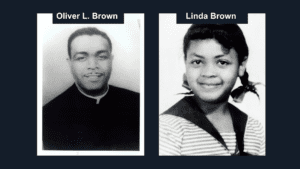

The centerpiece of Power to Inspire 2024, this original multimedia performance, “Courageous Steps: Bridging the Divide for Equality,” by playwright, Nikki Toombs, uses dialogue, music, and dance to address equity in education and the impact of Brown v. Board of Education. The show follows several students as they grapple with the impact of Brown today. Guests will be transported to 1954 where Thurgood Marshall, civil rights lawyer and future Supreme Court Justice, and his team of lawyers prepare to argue Brown before the Court. They also meet a young person preparing to be the first Black student to integrate her school and hear stories about the trials and triumphs of integration.
Brown v. Board of Education’s aspiration of equity in education for all is still a work in progress today. Marshall’s urging to, “stop talking about how far we’ve come and start talking about how close we are,” is our call to action. “Courageous Steps,” emphasizes that we all have the power to create change. By contributing to our communities in meaningful ways, deepening our sense of empathy, and exercising our collective power to vote, we can bridge the divide in education.
Join us as we celebrate the 70th anniversary of Brown v. Board of Education and The Center’s 10th anniversary!
Tickets include admission to the show, passed hors-d’oeuvres, and two free drink tickets.
Celebrate The Center’s 10th anniversary with a rooftop afterparty! During our early bird ticket sales, a limited number of afterparty tickets will be available to add to your early bird ticket purchase.
Throughout the history of the United States, racial injustice and inequity have fueled many court cases, leading to landmark court decisions aiming to eliminate racial tension and division. One of the most important of these court cases is Brown v. Board of Education in Topeka, Kansas, as it forced the Supreme Court to uphold the 14th Amendment and challenged another landmark case, Plessy v. Ferguson.
Scenes from the case:




The 14th Amendment & Plessy v. Ferguson
The 14th Amendment grants citizenship to all persons “born or naturalized in the United States” and provides “equal protection to all under the laws.” However, Plessy v. Ferguson (1896) established the constitutionality of laws mandating separate but equal accommodations for African Americans and whites in public areas, essentially legalizing segregation in public places, including schools.
The Five Cases
The legal milestone known as Brown v. Board of Education encompassed five distinct cases presented before the U.S. Supreme Court, all addressing the matter of segregation in public schools. The cases included:
Although each case had unique circumstances, they collectively scrutinized the constitutionality of state-endorsed segregation within public school systems.
Thurgood Marshall & Oliver Brown
Almost 50 years after the Plessy v. Ferguson ruling, Oliver Brown and other parents were the plaintiffs in the Brown v. Board of Education case, which challenged school segregation in Topeka, Kansas. Represented by attorneys from the NAACP Legal Defense Fund, including Thurgood Marshall, Brown argued that segregation violated the Fourteenth Amendment’s Equal Protection Clause. Their collective efforts resulted in a landmark Supreme Court ruling that declared segregation in public schools unconstitutional, marking a significant victory for the civil rights movement.
Leading the charge was Oliver Brown, the father of Linda Brown, a 3rd-grade student who was denied access to white schools closer to her home and forced to go to a Black school miles away.
The Legal Team
These lawyers, along with others, worked tirelessly to challenge segregation in public schools and advance the cause of civil rights in the United States. Their efforts ultimately led to the historic Supreme Court decision in Brown v. Board of Education, which declared racial segregation in public schools unconstitutional.
Division in the Supreme Court
When the Supreme Court initially heard the case in 1953, the justices were so divided that they decided to put it on hold until the Plaintiffs could present new briefs and arguments. When they resumed in 1954, Earl Warren of California, who opposed segregation, was the new Chief Justice. Warren knew the importance of a unanimous decision, but division among the justices continued. Some believed separate but equal was a state’s decision, while others thought it was a federal issue. Warren rewrote the language of the decision, focusing on the effects of segregation rather than the legitimacy of separate but equal institutions until the justices reached a unanimous decision.
The Decision
On May 17, 1954, the U.S. Supreme Court ruled that separating public school children based on race violated the equal protection clause of the 14th Amendment, making it unconstitutional. The decision ended legalized racial segregation and overruling the separate but equal principles of Plessy v. Ferguson. However, the challenge of enforcing the ruling remained. Just over one year later, on May 31, 1955, Warren read the Court’s unanimous decision, now called Brown II, instructing the states to begin desegregation plans “with all deliberate speed.”
The Brown v. Board of Education ruling catalyzed the civil rights movement, leading to the passage of legislation advancing equity, including the Civil Rights Act and the Voting Rights Act.
Thank you to our sponsors for supporting The Center!

Funding for this program is provided by the Fulton County Board of Commissioners. 